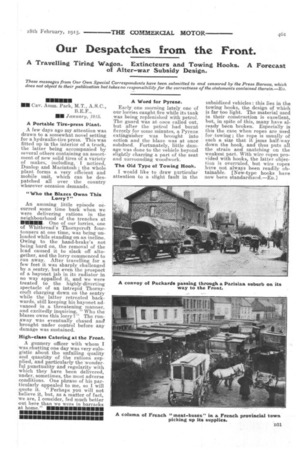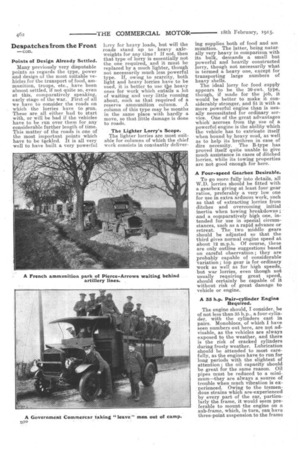Our Despatches from the Front.
Page 13

Page 14

Page 15

If you've noticed an error in this article please click here to report it so we can fix it.
A Travelling Tiring Wagon. Extincteurs and Towing Hooks. A Forecast of After-war Subsidy Design.
These messages from Our Own Special Correspondents have been submitted to and censored by the Press Bureau, which does not object to their publication but takes no responsibility for the correctness of the statements contained therein.—En.
MENEM.
Cav. Amm. Park, M.T., A.S.C.,
RN January, 1915. A Portable Tire-press Plant.
A few days ago my attention was drawn to a somewhat novel setting for a hydraulic-tire press. This was fitted up in the interior of a truck, the latter being accompanied by several others containing an assortment of new solid tires of a variety of makes, including, I noticed, Dunlop and Macintosh ; the whole plant forms a very efficient and mobile unit, which can be despatched all over the country wherever occasion demands.
"Who the Blazes Owns This Lorry?"
An amusing little episode occurred some time back when we were delivering rations in the neighbourhood of the trenches at irommo. One of our lorries, one of Whitbread's Thornycroft fourtonners at one time, was being unloaded while standing on an incline. Owing to the hand-brake's not being hard on, the removal of the lcad caused it to slack off altogether, and the lorry commenced to run away. After travelling for a few feet it was sharply challenged by a sentry, but even the prospect of a bayonet jab in its radiator in no way appalled it, and we were treated to the highly-divexting spectacle of an intrepid Thornycroft charging down on the sentry while the latter retreated backwards, still keeping his bayonet advanced in a threatening manner, and excitedly inquiring, Who the blazes owns this lorry I" The runaway was eventually chased and brought under control before any damage was sustained.
High-class Catering at the Front.
A gunnery officer with whom I was chatting one day was very eulogistic about the unfailinF quality and quantity of the ration S supplied, and particularly the wonderfill punctuality and regularity with which they have been delivered, under, sometimes, the most adverse conditions. One phrase of his particularly appealed to me, so I will quote it. "Perhaps you will not believe it, but, as a matter of fact, we are, I consider, fed much better out here than we were in barracks at home." 1111.111.11•••••••• ••••••••••••••11111111111•11 A Word for Pyrene.
Early one morning lately one of our lorries caught fire while its tank was being replenished with petrol. The guard was at once called out, but after the petrol had burnt fiercely for some minutes, a Pyrene extinguisher was brought into action and the blaze was at once subdued. Fortunately, little damage was done to the vehicle beyond slightly charring a part of the seat and surrounding woodwork.
The Old Type of Towing Hook.
I would like to draw particular attention to a slight fault in the subsidized vehicles : this lies in the towing hooks, the design of which is far too light. The material used in their construction is excellent, but, in spite of this, many have already been broken. Especially is this the case when ropes are used for -towing ; the rope is usually of such a size that it jams half-way down the hook, and thus puts all the strain and snatching on the weakest part. With wire ropes provided with hooks, the latter objection is overruled, but. wire ropes have not always been readily obtainable. [New-type hooks have now been standardized.—E.]
Despatches from the Front
—.con.
Points of Design Already Settled.
Many previously very disputable points as regards the type, power and design of the most suitable vehicles for the transport of food, ammunition, troops, etc., have been almost settled, if not quite so, even at this, comparatively speaking, early stage of the war. First of all we have to consider the roads on which the lorries have to Fun. These are all either bad to start with, or will be had if the vehicles have to be run over them for any considerable further length of time. This matter of the roads is .one of the most important points which have to be tackled. It is all very well to have built a very powerful lorry for heavy loads, but will the roads stand up to heavy axleweights for any time ? If not, then that type of lorry is essentially not the one required, and it must be replaced by a much lighter, though not necessarily much less powerful type. If, owing to scarcity, both light and heavy lorries have to be used, it is better to use tJe heavy ones for work which entails a lot of waiting and very little running about, such as that required of a reserve ammunition column. A column of this type may be months in the same place with hardly a move, so that little damage is done to roads.
The Lighter Lorry's Scope. The lighter lorries are most suitable for columns of which the chief work consists in constantly deliver ing supplies both of food and am munition. The latter, being naturally very heavy in comparison with its bulk, demands a small but powerful and heavily constructed lorry, though not necessarily what is termed a heavy one, except for transporting large numbers of heavy shells.
The ideal lorry for food supply appears to be the 30-cwt. type, though, if made for the job, it would be better to make it considerably stranger, and fit it with a more powerful engine than is usually necessitated for ordinary service. One .of the great advantages which accrues from the Ilse of a powerful engine is the ability which the vehicle has to extricate itself when bound by heavy mud, as well as to help its brethren in case of dire necessity. The B-type has proved itself quite unable to give much assistance in eases of ditched lorries, while its towing properties are not good enough for here.
A Four-speed Gearbox Desirable.
To go more fully into details, all W.D. lorries should be fitted with a gearbox giving at least four gear ratios, preferably a very low one for use in extra arduous work, such as that of extracting lorries from ditches and overcoming initial inertia when towing breakdowns ;• and a comparatively high one, intended for use in special circumstances, such as a rapid advance or retreat. Thetwo middle gears should be adjusted so that the third gives normal engine speed at about 12 m.p.h. Of course, these are only outline suggestions based on careful observation ; they are probably capable of considerable variation ; top gear is for ordinary work as well a-s for high speeds, but war lorries, even though not usually requiring great speed, should certainly be capable of it without risk of great damage to vehicle or engine.
A 35 h.p. Pair-cylinder Engine Required.
The engine should, I consider, be of not less than 35 h.p., a four-cylinder, with the cylinders cast in pairs. Monoblocs of which I have seen numbers out 'here, are not advisable, as the vehicles are always exposed to the weather, and there is the risk of cracked cylinders during frosty weather. Lubrication should be attended to most carefully, as the engines have to run for long periods with the slightest of attention ; the oil capacity should be great for the same reason. Oil pipes must be reduced to a minimum—they are always a source of trouble when much vibration is experienced. Owing to the tremendous strains which are experienced by every part of the car, particularly the frame, it would seem preferable to mount the engine on a sub-frame, which, in turn, can have three-point suspension to the frame
Despatch—con.
proper. For the same reason the latter should preferably be of the flexible type, otherwise a bad ditching might easily cause permanent setting.
The Final-drive Problem.
An important point to decide on is the relative suitability of chain, bevel and worm final drives ; chain drive is fitted to many cars which have done most excellent service out here, a particular example being the Comnaercars. But I believe that, except for the heaviest work, bevel or worm drive will
prove, on the whole, to be better. For very heavy work the rear axles with the latter forms of drive may prove—and, in fact, have proved— severe on tires, owing to the great unsprung weight. With chain drive, in order to obtain the requisite gear ratios without unduly small sprocket wheels, the chain wheels have to be of large size—not a great deal smaller than the wheels themselves. The result is that, when running on the edge of a pave road, where the drop from the pave to the ground at the sides may be anything from an inch to a foot, it is quite possible that the chain wheels may drag or work for some little distance on the pave, with consequent risk of damage. If chain cases be fitted, the clearance is even less, but if the cases are very strong, damage to the chains or chain wheels may be prevented. One of the best means for assisting a lorry to extract itself from soft ground is to wind ropes or chains across and round the tires, between the spokes of the rear wheels. With chain drive this is difficult to accomplish owing to the risk of fouling the chains or their cases.
Worm v. Bevel at the Front. Silence Essential.
As regards worm v. bevel drive, the worm type is, I believe, the more suitable, as it allows rather more back-axle ground clearance for the same gear reduction, and is, also considerably more silent. The latter property is of rather greater importance than might generally be considered. A long column of lorries will certainly make a considerable noise, and, under certain circumstances, it is essential that this should be reduced to the minimum. If engines and gearboxes be fairly quiet, the hum of the bevels, can be distinctly heard from a considerable distance, whereas worm gearing is absolutely silent.
A Spring Drive Suggested.
For pave or other bad roads it would be advisable to fit some type of spring device in the transmission between engine and back aide. At present the whole transmission is subjected to a great amount of snatching, which might be 'alleviated by this means. For the same reason, the strain of the drive should not be taken by the rear springs, as is sometimes done. A further disadvantage of the latter method is that loading and unloading usually cause the brakes to. bind or slacken respectively.
Needless to say, springs should have a great amount of attention, as these are a source of much trouble in many vehicles, and shackle and pad bolts must be of very stout design. All nuts must be well split-pinned, and, wherever necessary, greasers of large capacity should be provided.
Few Steering-gear Troubles.
I cannot criticise steering much, as very little trouble has been experienced with this part on the vehicles with which I have had to deal directly, or of which I have heard from other columns ; some, however, I have noticed are far too sensitive to road shocks, and are thus very tiring to handle for any considerable distances.
Such minor details as large cocks and orifices for rapidly emptying and filling radiators and petrol tanks should be well considered.
I hope, at a later date, to draw attention to other details, the design of which might be either improved or almost standardized.




















